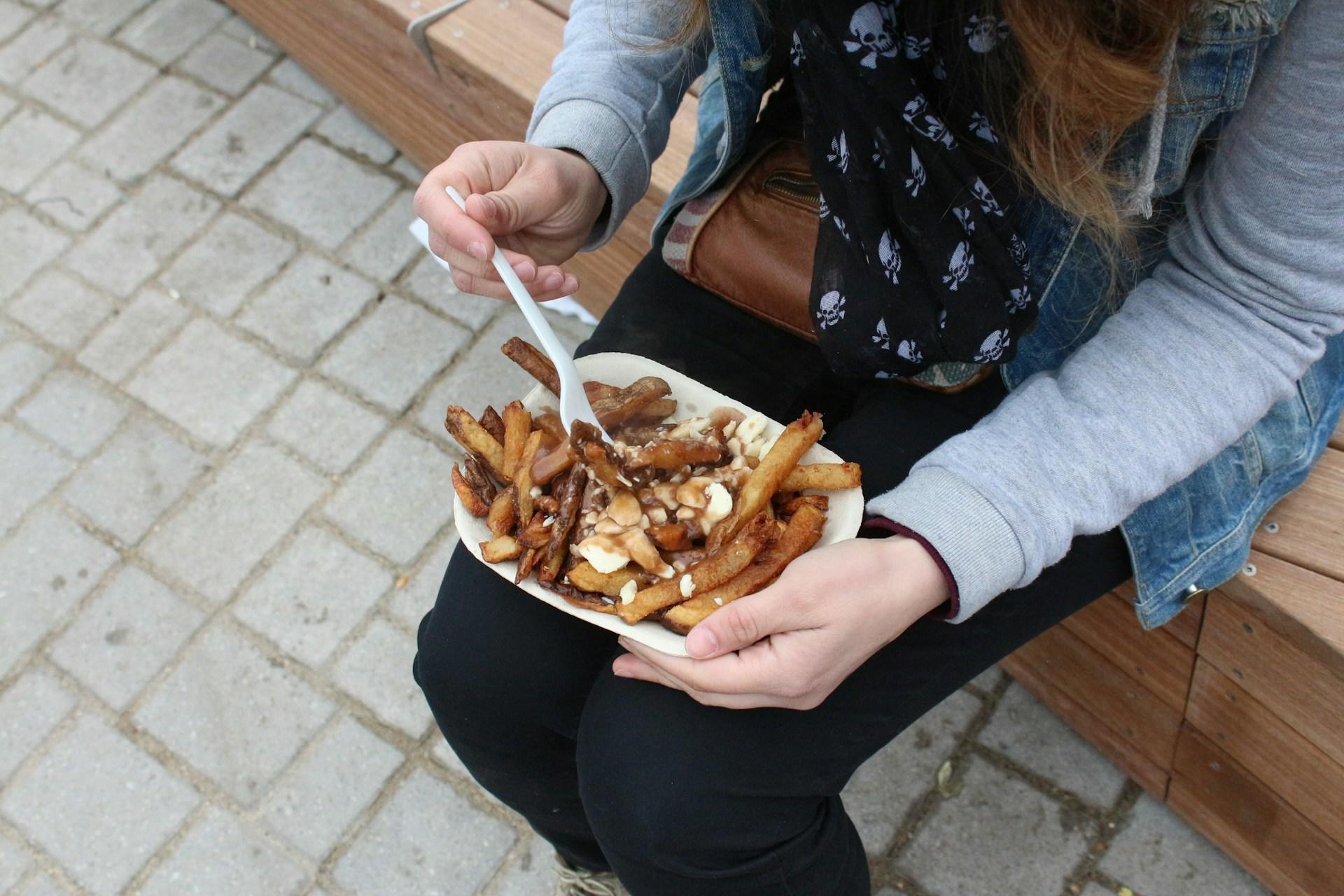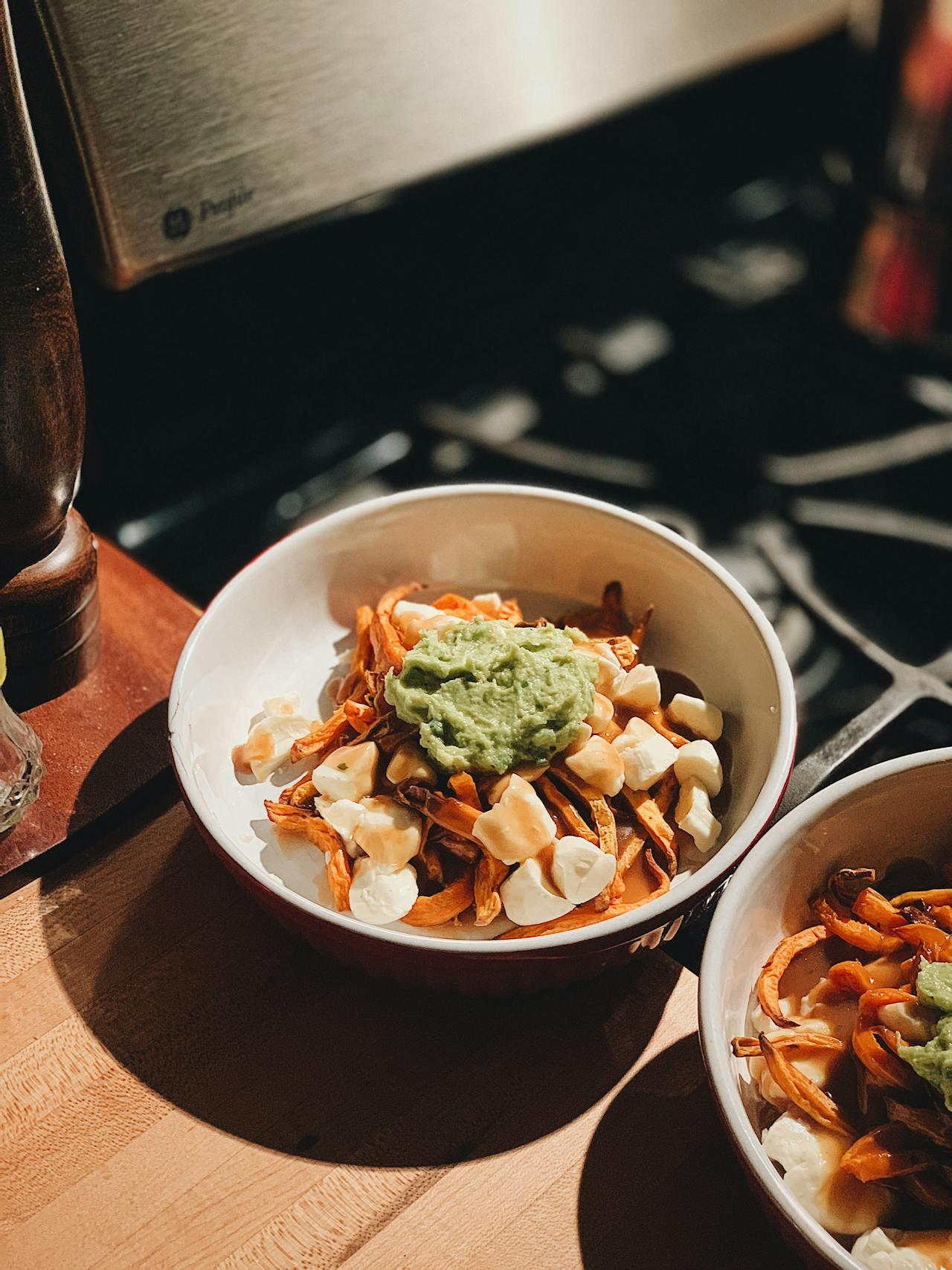Poutine, much more than a simple combination of French fries, cheese curds, and gravy, reflects Quebec's deep culinary roots. This signature warm dish, which emerged in rural communities in the mid-20th century, evolved to become a dish of great popularity not only in Canada but also in other countries. Although there are various theories about its origin, this classic dish remains one of the most beloved Canadian foods, especially during cold Canadian winters.

The origin of the term "Poutine"
The word "poutine" could be derived from the English pudding or its French equivalent, pouding, both used to describe a mixture or combination of foods. However, historians still debate the exact etymological origin. However, while there are alternative versions of poutine's origins, many agree that poutine took shape in the rural areas of mid-20th-century Quebec.

Legends about Poutine's origins
Discovering the story behind classic Canadian dishes like poutine offers a great opportunity to understand the intertwined nature of history, traditions, and culinary culture. There are several stories about the creation of poutine in Canada, two of the most well-known originating in Quebec:
Warwick and the Story of Fernand Lachance 🍔
This legend is one of the most cited that traces poutines creation back to the 1950s at Le Lutin Qui Rit, located in Warwick, east of Montreal. According to this version, a customer asked Fernand Lachance, the restaurant's owner to add cheese curds to his fries. Lachance, surprised, replied: "Ça va faire une maudite poutine," translating to "That's going to make a big mess". It should be noted that in Quebec, the term "poutine" is used colloquially to describe a mess.
"Ça va faire une maudite poutine!"
Fernand Lachance
Drummondville and the Roy Jucep restaurant 🍴
Another popular version attributes the invention of poutine to Jean-Paul Roy, owner of the Roy Jucep restaurant in Drummondville, in the Québec region. Roy was the first to officially sell the mix of the three ingredients in 1964, which is why his restaurant is recognized as the birthplace of poutine.
Jean-Paul Roy has been known since the end of the 1950s for his mixture of fries and brown sauce (gravy), to which he occasionally added a little cheese curd to make his customers happier. When Jean-Paul Roy acquired Jucep's restaurant in the early 1960s, he figured it would be good to name this culinary specialty to simplify the servers' duties, he named it poutine!
The name "poutine" may have been inspired by one of his cooks, called Ti-Pout. The narrative tells that the phrase "Ti-Pout makes poutine" originated during a creative brainstorming session among the staff, eventually inspiring the famous name for the dish.
Did you know you can find the word "Poutine" in the Merriam-Webster dictionary 2014?
Poutine is defined as "a dish of fried potatoes topped with brown gravy and cheese curds."
Becoming popular across the country
The Canadian Encyclopedia documents the rise of poutine as a national phenomenon in the 1990s, marking its transition from a local dish to a culinary symbol of national scope. Today, poutine is easily found in fast-food chains, specialty restaurants, and outlets devoted exclusively to the dish, reflecting how Quebec's culinary heritage has spread across Canada.
Although poutine had begun to be marketed earlier, its popularity spiked in the late 1980s and early 1990s thanks to its incorporation into the menus of major dining franchises. Burger King added poutine to their Ontario menu in 1987, extending its popularity beyond Quebec. Shortly after that, in the 1990s, McDonald's and Harvey (1992), adopted the phenomenon.
Later, specialty dining franchises such as Smoke's Poutinerie (2008) and Poutini's House of Poutine (2009) took the dish to new levels of popularity, offering creative and unique versions.
Various interpretations of the classic poutine dish emerged over the years, adapting to different palates and trends. Among these innovative versions of the dish are vegetarian options, lobster poutine (mainly found in Nova Scotia), and, for example, a butter chicken poutine, a popular fusion in Indo-Canadian communities. These recipe variations have broadened the appeal of poutine and reflect Canada's cultural and gastronomic diversity.
Additionally, poutine is celebrated annually across cities like Montreal, Quebec, Drummondville (one of its reputed origins), Toronto, and Ottawa. There are also popular poutine festivals outside Canada, mainly in Maine, New Hampshire, and Massachusetts.


Canada's controversial culinary treasure
Although poutine is considered the country's national dish for many Canadians, others argue that this overlooks its roots, culinary traditions, and cultural significance in Quebec. Additionally, in 2003 poutine became a central topic in public health discussions surrounding school meal standards in Canada. In Toronto, a group of mothers called the "poutine police" advocated removing poutine from school cafeterias due to its high caloric intake and replacing it with healthier alternatives.
In Quebec, the youth wing of the Quebec Liberal Party proposed banning poutine from school canteens. However, Premier Jean Charest rejected this suggestion.
Would you like to discover a delicious Canadian no-bake dessert that is so tasty we must eat it occasionally?
Traditional Poutine recipe
While poutine recipes may vary by region, the three fundamental ingredients of this iconic Canadian dish remain constant: French fries, cheese curds, and gravy. Below, we break down each element to understand what it takes to prepare a traditional poutine.
The poutine's base is French fries. Fried for 4 or 5 minutes with vegetable oil, potatoes are cooked to a crispy, golden brown exterior while keeping a tender inside. This contrast of textures is essential to support the weight of the cheese curds and sauce without losing their shape or texture.
Fresh cheese curds add a distinctive texture and acidic taste to the dish's balance and charm, and their size and amount are adjustable based on preferences.
A rich, savory gravy ties this classic delicacy together. The brown gravy is typically prepared using beef or chicken broth stock, adding a subtle salty flavor with peppery notes. In Quebec, Ontario, and the Maritime provinces, pre-made poutine sauces are available, and some grocery shops even sell their own branded versions.
The perfect textures in the poutine require the right temperature, time, and sequence when assembling the ingredients. The gravy and cheese curds are added just before serving to keep the fries crunchy. The hot sauce is usually poured over the curd at room temperature, which allows it to warm slightly without melting completely. The thin consistency of the sauce ensures that it coats all the potatoes fries evenly. 🍟
Still hungry? Discover one of the most famous meat pies of French-Canadian cuisine.

Looking for private cooking classes in Canada?
Canada's culinary traditions represent its rich cultural diversity. Whether you're an experienced cook looking to enhance your technique or curious about a new creative hobby, this is the sign you were searching for to expand your culinary knowledge. Go to Superprof, one of Canada's top online private teaching platforms, to learn about cooking.
Superprof makes it simple to choose a private instructor who can meet your goals and learning style. Through specialized private tuition, Superprof instruction is designed for everyone, regardless of skill level and knowledge, to reach their culinary objectives. Its easy-to-use platform lets you quickly search for the ideal cooking classes to master, for example:
- The fundamental cooking techniques: Through private tutoring, you will learn the cooking methods all cooks must master, from basic cutting techniques to advanced culinary practices like improvisational cooking and precise oven control. These foundational skills will equip you to confidently explore and execute food recipes like a professional.
- Canada's culinary food traditions: With the proper instruction you will dive into the origins and evolution of traditional Canadian cuisine while exploring iconic dishes. Gain insights into how ingredients and cooking techniques have been transformed and shaped by Canadian trends and global influence.
- The type of cuisine you are interested in: Discover personalized cooking lessons designed to meet your goals. Whether you want to learn the cooking basics, improve your French baking skills, or explore Mediterranean fresh cuisine, Superprof guides you every step of the way.
Superprof makes it easy for culinary enthusiasts to gain hands-on experience, grow their confidence in the kitchen, and develop a deeper appreciation for cooking. Are you ready to discover your passion for cooking? Let's get started with Superprof!
Want something sugary? Try one of the most emblematic desserts in Canada!
Did you know that poutine holds a spot in the Guinness World Records?
In 2014, Joe Beeverz, a restaurant in Brandon, Manitoba, set the record for the world's largest poutine. Weighing an impressive 884.09 kilograms, this feat really exemplifies Canada's love for this iconic dish.
Wrap Up!
Today, poutine is a traditional Canadian delicacy that transcends its original recipe and borders. Dedicated festivals, culinary innovations, and a Guinness World Record testify to the importance of this conventional Quebec dish. Despite its controversies, this dish retains its essence between tradition and creativity. In every variation, from classic to exotic and even gourmet, poutine remains a reflection of the tremendous cultural diversity that Canada is home to.
Curious about Canada's culinary treasures? Discover the most famous natural sweetener obtained from maple sap.
















